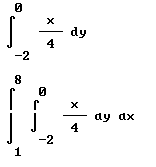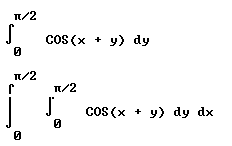
If your solution to stated problem does not match the given solution, you should self-critique per instructions at
http://vhcc2.vhcc.edu/dsmith/geninfo/labrynth_created_fall_05/levl1_22/levl2_81/file3_259.htm
.
Your solution, attempt at solution. If you are unable to attempt a solution, give a phrase-by-phrase interpretation of the problem along with a statement of what you do or do not understand about it. This response should be given, based on the work you did in completing the assignment, before you look at the given solution.
At the end of this document, after the qa problems (which provide you with questions and solutions), there is a series of Questions, Problems and Exercises.
Question: `q001. Evaluate the double integral over R with respect to A of x/4 where R: 1 <= x <= 8, -2 <= y <= 0.
Your solution:
Confidence rating:
Given Solution:
The region runs from x = 1 to x = 8. For each value of x, y runs from -2 to 0.So the integral is
int( (int( x / 4 dy, -2, 0) dx, 1, 8) ).
The inner integral, then the complete double integral, are written

The inner integral is with respect to y, so x^2 / 4 is treated as a constant, and an antiderivative is just x / 4 * y (note that y is an antiderivative of 1). Evaluating between limits -2 and 0 we get (x/4 * 0) - (x/4 * (-2)) = x / 2.
The outer integral is then int(x/2 dx, 1, 8), written

This integral is easily evaluated. We get 63 / 4.
The integral could be interpreted as the mass of a rectangular of dimensions 7 units by 2 units, with a density x / 4 that varies linearly from 1/2 to 2 as we move along the 7 unit length. The average density would be 9/8, the area is 14, so the mass is 9/8 * 14 = 63/4.
Self-critique (if necessary):
Self-critique rating:
Question: `q002: Compute the double integral over R with respect to A of cos(x+y) where R: 0 <= x <= pi/2, 0 <= y <= pi/2.
Your solution:
Confidence rating:
Given Solution:
Choosing to integrate first with respect to y, the inner integral is int(cos(x+y) dy, 0, pi/2), which is equal to sin(x+y) evaluated between y = 0 and pi/2.The resulting inner integral is therefore sin(x + pi/2) - sin(x).
The entire double integral is
int ( int(cos(x+y) dy, 0, pi/2) dx, 0, pi/2) = int((sin(x+pi/2) - sin(x)) dx, 0, pi/2). Using -cos(x + pi/2) and - cos(x) as antiderivatives and evalutating between x = 0 and pi/2, we get -cos(pi) - (-cos(pi/2) ) - cos(pi/2) - cos(0) = -(-1) - 0 - 0 - 1 = 0

Self-critique (if necessary):
Self-critique rating:
Question: `q003. Find the volume of the solid bounded above by the graph of z = f(x,y) and below by the xy-plane when f(x,y) = ye^(xy) and R: 0 <= x <= ln2, 0 <= y <= 1.
We integrate the vertical distance from the plane to the graph, with respect to area, over the given region.Choosing to integrate first with respect to x (we could as well have chosen y first), we get inner integral
int( y e^(x y) dy, 0, 1).
Then integrating this with respect to x we obtain our double integral
int(.int( y e^(x y) dy, 0, 1),x,0, ln(2))
For the inner integral x is treated as a constant.
We must integrate y e^(x y) with respect to y, for which we use integration by parts with u = y and dv = e^(x y) dy.
We get du = dy and v = 1/x e^(x y), so that our antiderivative is
u v - int(v du) = y / x e^(x y) - 1/x int ( e^(x y) dy) = y/x e^(x y) - 1/x^2 e^(x y).
Evaluating between y limits 0 and 1 we get 1/x e^x - 1/x^2 e^x - (0/x * e^0 - 1 / x^2 * e^0 ) = e^x ( 1/x - 1/x^2) + 1 / x^2.
Unfortunately e^x / x cannot be integrated in closed form.
Your solution:
Confidence rating:
Given Solution:
Self-critique (if necessary):
Self-critique rating:
Question: `q004. Use a grid with 16 cells to approximate the volume under the surface of 4 - x^2 - y^2, above the rectangle R: 0 <= x <=1, 0 <= y <= 1.
Your solution:
Confidence rating:
Given Solution:
A grid with 16 cells could correspond to a partition of the x interval [0, 1]
into subintervals [0, .25], [.25, .50], [.50, .75], [.75, 1.00], and the y
interval [0, 1] also into subintervals [0, .25], [.25, .50], [.50, .75], [.75,
1.00].
We might number the x intervals with index i, which takes values 1, 2, 3, and 4,
and the y intervals with index j, also taking values 1, 2, 3, 4.
With this numbering the region 0 <= x <= .25, .50 <= y <= .75 would be the i =
1, j = 3 interval. Its length in the x direction is `dx_1 = .25, its width in
the y direction is `dy_3 = .25, so its area is `dA_1,3 = .25 * .25 = .0625.
(more generally the area of the region defined by the ith x interval and the jth
y interval would be denoted `dA_i,j = `dx_i * `dy_j).
For sample points we could use x coordinates .2, .3, .6 and .9, with y
coordinates .1, .4, .7 and .8. Each sample coordinate is within the
corresponding interval (e.g., using 'hat' to denote sample points, x_1_hat = .2
is in the i = 1 interval of the x partition, the interval [0, .25], and the j =
3 interval [.50, .75] contains the point y_3_hat = .7).
Using this scheme the point (x_1_hat, y_3_hat) = (.2, .7) would be the sample
point of the i,j = 1, 3 region of the plane, which has area A_i,j = A_1,3 =
.0625.
Our sample coordinates are not completely random within the various intervals,
but they illustrate how any point in an interval can serve as a sample point.
Thus our partition divides the region up into 16 squares, indexed 1, 1 throug
1,4. Each square has dimension `dx = 1/4 by `dy = 1/4, and hence has total area
1/4 * 1/4 = 1/16.
The resulting sample points, values of z = 4 - x^2 - y^2, and contributions to
the integral (calculated by value * area increment) are
sample point ( 0.2 , 0.1 ); evaluating function: z = 3.95 . Value * area
increment = 0.246875
sample point ( 0.3 , 0.1 ); evaluating function: z = 3.9 . Value * area
increment = 0.24375
sample point ( 0.6 , 0.1 ); evaluating function: z = 3.63 . Value * area
increment = 0.226875
sample point ( 0.9 , 0.1 ); evaluating function: z = 3.18 . Value * area
increment = 0.19875
sample point ( 0.2 , 0.4 ); evaluating function: z = 3.8 . Value * area
increment = 0.2375
sample point ( 0.3 , 0.4 ); evaluating function: z = 3.75 . Value * area
increment = 0.234375
sample point ( 0.6 , 0.4 ); evaluating function: z = 3.48 . Value * area
increment = 0.2175
sample point ( 0.9 , 0.4 ); evaluating function: z = 3.03 . Value * area
increment = 0.189375
sample point ( 0.2 , 0.7 ); evaluating function: z = 3.47 . Value * area
increment = 0.216875
sample point ( 0.3 , 0.7 ); evaluating function: z = 3.42 . Value * area
increment = 0.21375
sample point ( 0.6 , 0.7 ); evaluating function: z = 3.15 . Value * area
increment = 0.196875
sample point ( 0.9 , 0.7 ); evaluating function: z = 2.7 . Value * area
increment = 0.16875
sample point ( 0.2 , 0.9 ); evaluating function: z = 3.15 . Value * area
increment = 0.196875
sample point ( 0.3 , 0.9 ); evaluating function: z = 3.1 . Value * area
increment = 0.19375
sample point ( 0.6 , 0.9 ); evaluating function: z = 2.83 . Value * area
increment = 0.176875
sample point ( 0.9 , 0.9 ); evaluating function: z = 2.38 . Value * area
increment = 0.14875
We add the contributions of the 16 area increments to get our total
approximation: 3.3075
Naturally a different selection of sample points would be expected to provide a different total. However there isn't that much room to move around in any square, so our sample point couldn't be too far from the sample point chosen here. No matter where the sample points are chosen, we would probably expect the final result to be reasonably close to the 3.3 obtained here. If the sample points are chosen at random (vs., for example, choosing a point very close to the upper right-hand corner of each interval, which is far from a random choice), we would expect to be closer to 3.3 than if we had made a completely random choice of the sample point.
Note: the exact value of the integral is 10/3 = 3.33, quite close to the value obtained here.
Note: The integral approximated here is

Self-critique (if necessary):
Self-critique rating:
Question: `q005. Let R be a rectangular region within the boundary of a certain city defined by R: -2 <= x <= 3, -1 <= y <= 1. The units are in miles and (0,0) is the city center. Assume the population density is 13*e^(-0.08 * r) thousand people per square mile and r = sqrt(x^2 + y^2). Give the double integral which will model the total population of this region. Do not, however, solve the integral.
Your solution:
Confidence rating:
Given Solution:
If we partition the x and y intervals in the usual manner, so that the typical region has dimensions `dx_i by `dy_i and contains sample point (x_i_hat, y_j_hat), then the region has area A_ij = `dx_i * `dy_j. The population density is given in terms of r, the distance from the point (0, 0). The point (x_i_hat, y_j_hat) lies at distance sqrt( (x_i_hat)^2 + (y_j_hat)^2 ) from the center, so the population density is 13 e^(-.08 r) = 13 e^(-.08 * sqrt((x_i_hat)^2 + (y_j_hat)^2 ) ).
If we sum over all such regions and take the limit as the `dx and `dy increments approach zero, our sum approaches the integral
int ( int(13 e^(-.08 sqrt(x^2 + y^2) ) dy, y from -1 to 1) dx, x from -2 to 3). In standard notation:
Self-critique (if necessary):
Self-critique rating: